Enhanced Dissolution of Sildenafil Citrate Using Solid Dispersion with Hydrophilic Polymers: Physicochemical Characterization and In Vivo Sexual Behavior Studies in Male Rats
Abstract
:1. Introduction
2. Materials and Methods
2.1. Materials
2.2. Preparation of SLC Solid Dispersion by Solvent Evaporation
2.3. Practical Percentage Yield
2.4. Drug Content Estimation
2.5. Differential Scanning Calorimetry (DSC) Studies
2.6. Fourier Transform Infra-Red (FTIR) Spectroscopy
2.7. Powder X-ray Diffraction (PXRD) Studies
2.8. Scanning Electron Microscopy (SEM)
2.9. In Vitro Release Studies
2.9.1. Mean Dissolution Time (MDT)
2.9.2. Similarity Index (F2)
2.9.3. Drug Release Kinetics
2.10. In Vivo Sexual Behavior Studies
2.10.1. Animals
2.10.2. Preparation of Male and Female Rats
2.10.3. Experimental Procedure
2.10.4. Monitoring of Sexual Behavior
2.11. Statistical Evaluation
3. Results and Discussion
3.1. Practical Percentage Yield
3.2. Drug Content Estimation of Solid Dispersions
3.3. DSC Studies
3.4. FTIR Studies
3.5. PXRD Studies
3.6. SEM
3.7. In Vitro Release Studies
3.8. In Vivo Sexual Behavior Studies
4. Conclusions
Author Contributions
Funding
Data Availability Statement
Acknowledgments
Conflicts of Interest
References
- Yafi, F.A.; Jenkins, L.; Albersen, M.; Corona, G.; Isidori, A.M.; Goldfarb, S.; Maggi, M.; Nelson, C.J.; Parish, S.; Salonia, A.; et al. Erectile dysfunction. Nature reviews. Dis. Primers 2016, 2, 16003. [Google Scholar] [CrossRef]
- Sikka, S.C.; Hellstrom, W.J.; Brock, G.; Morales, A.M. Standardization of vascular assessment of erectile dysfunction: Standard operating procedures for duplex ultrasound. J. Sex Med. 2013, 10, 120–129. [Google Scholar] [CrossRef] [PubMed]
- Manecke, R.G.; Mulhall, J.P. Medical treatment of erectile dysfunction. Ann. Med. 1999, 31, 388–398. [Google Scholar] [CrossRef] [PubMed]
- Jung, S.-Y.; Seo, Y.-G.; Kim, G.K.; Woo, J.S.; Yong, C.S.; Choi, H.-G. Comparison of the solubility and pharmacokinetics of sildenafil salts. Arch. Pharm. Res. 2011, 34, 451–454. [Google Scholar] [CrossRef] [PubMed]
- Shin, H.S.; Bae, S.K.; Lee, M.G. Pharmacokinetics of sildenafil after intravenous and oral administration in rats: Hepatic and intestinal first-pass effects. Int. J. Pharm. 2006, 320, 64–70. [Google Scholar] [CrossRef]
- Sawatdee, S.; Phetmung, H.; Srichana, T. Sildenafil citrate monohydrate-cyclodextrin nanosuspension complexes for use in metered-dose inhalers. Int. J. Pharm. 2013, 455, 248–258. [Google Scholar] [CrossRef]
- Atipairin, A.; Sawatdee, S. Inclusion complexes between sildenafil citrate and cyclodextrins enhance drug solubility. Asian J. Pharm. Sci. 2016, 11, 104–105. [Google Scholar] [CrossRef]
- Hosny, K.M.; El-Say, K.M.; Ahmed, O.A. Optimized sildenafil citrate fast orodissolvable film: A promising formula for overcoming the barriers hindering erectile dysfunction treatment. Drug Deliv. 2016, 23, 355–361. [Google Scholar] [CrossRef] [Green Version]
- Sawatdee, S.; Atipairin, A.; Yoon, A.S.; Srichana, T.; Changsan, N.; Suwandecha, T.; Chanthorn, W.; Phoem, A. Oral bioavailability and pharmacokinetics of sildenafil citrate dry foam tablets in rats. Cogent Med. 2018, 5. [Google Scholar] [CrossRef]
- Sanphui, P.; Tothadi, S.; Ganguly, S.; Desiraju, G.R. Salt and Cocrystals of Sildenafil with Dicarboxylic Acids: Solubility and Pharmacokinetic Advantage of the Glutarate Salt. Mol. Pharm. 2013, 10, 4687–4697. [Google Scholar] [CrossRef]
- Hosny, K.M.; Alhakamy, N.A.; Almodhwahi, M.A.; Kurakula, M.; Almehmady, A.M.; Elgebaly, S.S. Self-Nanoemulsifying System Loaded with Sildenafil Citrate and Incorporated within Oral Lyophilized Flash Tablets: Preparation, Optimization, and In Vivo Evaluation. Pharmaceutics 2020, 12, 1124. [Google Scholar] [CrossRef]
- Ahmed, M.M.; Fatima, F.; Anwer, M.K.; Aldawsari, M.F.; Soliman, G.A.; Fayed, M.H. Development and Characterization of Spray-dried Amorphous Solid Dispersion of Sildenafil: In vivo Evaluation. Int. J. Pharmacol. 2020, 16, 460–469. [Google Scholar] [CrossRef]
- Vo, C.L.; Park, C.; Lee, B. Current trends and future perspectives of solid dispersions containing poorly water-soluble drugs. Eur. J. Pharm. Biopharm. 2013, 85, 799–813. [Google Scholar] [CrossRef]
- Aldawsari, M.; Ahmed, M.; Fatima, F.; Anwer, M.K.; Katakam, P.; Khan, A. Development and Characterization of Calcium-Alginate Beads of Apigenin: In Vitro Antitumor, Antibacterial, and Antioxidant Activities. Mar. Drugs 2021, 19, 467. [Google Scholar] [CrossRef] [PubMed]
- Zhang, X.; Xing, H.; Zhao, Y.; Ma, Z. Pharmaceutical Dispersion Techniques for Dissolution and Bioavailability Enhancement of Poorly Water-Soluble Drugs. Pharmaceutics 2018, 10, 74. [Google Scholar] [CrossRef] [PubMed] [Green Version]
- Meng, F.; Gala, U.; Chauhan, H. Classification of solid dispersions: Correlation to (i) stability and solubility (ii) preparation and characterization techniques. Drug Dev. Ind. Pharm. 2015, 41, 1401–1415. [Google Scholar] [CrossRef]
- Szafraniec-Szczęsny, J.; Antosik-Rogóż, A.; Kurek, M.; Gawlak, K.; Górska, A.; Peralta, S.; Knapik-Kowalczuk, J.; Kramarczyk, D.; Paluch, M.; Jachowicz, R. How Does the Addition of Kollidon®VA64 Inhibit the Recrystallization and Improve Ezetimibe Dissolution from Amorphous Solid Dispersions? Pharmaceutics 2021, 13, 147. [Google Scholar] [CrossRef]
- Nair, A.R.; Lakshman, Y.D.; Anand, V.S.K.; Sree, K.S.N.; Bhat, K.; Dengale, S.J. Overview of Extensively Employed Polymeric Carriers in Solid Dispersion Technology. AAPS PharmSciTech 2020, 21, 309. [Google Scholar] [CrossRef] [PubMed]
- Charalabidis, A.; Sfouni, M.; Bergström, C.; Macheras, P. The Biopharmaceutics Classification System (BCS) and the Biopharmaceutics Drug Disposition Classification System (BDDCS): Beyond guidelines. Int. J. Pharm. 2019, 566, 264–281. [Google Scholar] [CrossRef]
- LaFountaine, J.S.; McGinity, J.W.; Williams, R.O., 3rd. Challenges and Strategies in Thermal Processing of Amorphous Solid Dispersions: A Review. AAPS PharmSciTech 2016, 17, 43–55. [Google Scholar] [CrossRef] [Green Version]
- Li, B.; Konecke, S.; Harich, K.; Wegiel, L.; Taylor, L.S.; Edgar, K.J. Solid dispersion of quercetin in cellulose derivative matrices influences both solubility and stability. Carbohydr. Polym. 2013, 92, 2033–2040. [Google Scholar] [CrossRef]
- Solanki, N.G.; Lam, K.; Tahsin, M.; Gumaste, S.G.; Shah, A.V.; Serajuddin, A.T.M. Effects of Surfactants on Itraconazole-HPMCAS Solid Dispersion Prepared by Hot-Melt Extrusion I: Miscibility and Drug Release. J. Pharm. Sci. 2019, 108, 1453–1465. [Google Scholar] [CrossRef] [PubMed]
- Ali, W.; Williams, A.C.; Rawlinson, C.F. Stochiometrically governed molecular interactions in drug: Poloxamer solid dispersions. Int. J. Pharm. 2010, 391, 162–168. [Google Scholar] [CrossRef] [PubMed]
- Ramadhani, N.; Shabir, M.; McConville, C. Preparation and characterisation of Kolliphor® P 188 and P 237 solid dispersion oral tablets containing the poorly water soluble drug disulfiram. Int. J. Pharm. 2014, 475, 514–522. [Google Scholar] [CrossRef]
- Islam, N.; Irfan, M.; Khan, S.-U.-D.; Syed, H.K.; Iqbal, M.S.; Khan, I.U.; Mahdy, A.; Raafat, M.; Hossain, M.A.; Inam, S.; et al. Poloxamer-188 and D-α-Tocopheryl Polyethylene Glycol Succinate (TPGS-1000) Mixed Micelles Integrated Orodispersible Sublingual Films to Improve Oral Bioavailability of Ebastine; In Vitro and In Vivo Characterization. Pharmaceutics 2021, 13, 54. [Google Scholar] [CrossRef] [PubMed]
- Yen, S.; Chen, C.; Lee, M.; Chen, L. Investigation of Dissolution Enhancement of Nifedipine by Deposition on Superdisintegrants. Drug Dev. Ind. Pharm. 2008, 23, 313–317. [Google Scholar] [CrossRef]
- Alves, L.D.S.; Soares, M.F.D.L.R.; de Albuquerque, C.T.; da Silva, É.R.; Vieira, A.; Fontes, D.A.F.; Figueirêdo, C.B.M.; Sobrinho, J.L.S.; Neto, P.R. Solid dispersion of efavirenz in PVP K-30 by conventional solvent and kneading methods. Carbohydr. Polym. 2014, 104, 166–174. [Google Scholar] [CrossRef]
- Kolter, K.; Flick, D. Structure and dry binding activity of different polymers, including Kollidon VA 64. Drug Dev. Ind. Pharm. 2000, 26, 1159–1165. [Google Scholar] [CrossRef]
- Chaudhary, R.S.; Patel, C.; Sevak, V.; Chan, M. Effect of Kollidon VA®64 particle size and morphology as directly compressible excipient on tablet compression properties. Drug Dev. Ind. Pharm. 2018, 44, 19–29. [Google Scholar] [CrossRef] [PubMed]
- Moseson, D.E.; Parker, A.S.; Beaudoin, S.P.; Taylor, L.S. Amorphous solid dispersions containing residual crystallinity: Influence of seed properties and polymer adsorption on dissolution performance. Eur. J. Pharm. Sci. 2020, 146, 105276. [Google Scholar] [CrossRef]
- Chavan, R.B.; Lodagekar, A.; Yadav, B.; Shastri, N.R. Amorphous solid dispersion of nisoldipine by solvent evaporation technique: Preparation, characterization, in vitro, in vivo evaluation, and scale up feasibility study. Drug Deliv. Transl. Res. 2020, 10, 903–918. [Google Scholar] [CrossRef]
- Anwer, M.K.; Mohammad, M.; Ezzeldin, E.; Fatima, F.; Alalaiwe, A.; Iqbal, M. Preparation of sustained release apremilast-loaded PLGA nanoparticles: In vitro characterization and in vivo pharmacokinetic study in rats. Int. J. Nanomed. 2019, 14, 1587–1595. [Google Scholar] [CrossRef] [Green Version]
- Anwer, M.K.; Ahmed, M.M.; Alshetaili, A.; Almutairy, B.K.; Alalaiwe, A.; Fatima, F.; Ansari, M.N.; Iqbal, M. Preparation of spray dried amorphous solid dispersion of diosmin in soluplus with improved hepato-renoprotective activity: In vitro anti-oxidant and in-vivo safety studies. J. Drug Deliv. Sci. Technol. 2020, 60, 102101. [Google Scholar] [CrossRef]
- Alshehri, S.M.; Shakeel, F.; Ibrahim, M.A.; Elzayat, E.M.; Altamimi, M.; Mohsin, K.; Almeanazel, O.T.; Alkholief, M.; Alshetaili, A.; Alsulays, B.; et al. Dissolution and bioavailability improvement of bioactive apigenin using solid dispersions prepared by different techniques. Saudi Pharm. J. 2019, 27, 264–273. [Google Scholar] [CrossRef] [PubMed]
- Al-Shdefat, R.; Ali, B.E.; Anwer, M.K.; Fayed, M.H.; Alalaiwe, A.; Soliman, G.A. Sildenafil citrate-Glycyrrhizin/Eudragit binary spray dried microparticles: A sexual behavior studies on male rats. J. Drug Deliv. Sci. Technol. 2016, 36, 141–149. [Google Scholar] [CrossRef]
- Fouad, S.A.; Malaak, F.A.; El-Nabarawi, M.A.; Abu Zeid, K.; Ghoneim, A.M. Preparation of solid dispersion systems for enhanced dissolution of poorly water soluble diacerein: In-vitro evaluation, optimization and physiologically based pharmacokinetic modeling. PLoS ONE 2021, 16, e0245482. [Google Scholar] [CrossRef] [PubMed]
- Ahmed, M.M.; Fatima, F.; Abul Kalam, M.; Alshamsan, A.; Soliman, G.A.; Shaikh, A.A.; Alshahrani, S.M.; Aldawsari, M.F.; Bhatia, S.; Khalid Anwer, M. Development of spray-dried amorphous solid dispersions of tadalafil using glycyrrhizin for enhanced dissolution and aphrodisiac activity in male rats. Saudi Pharm. J. 2020, 28, 1817–1826. [Google Scholar] [CrossRef] [PubMed]
- Besong, E.B.; Ateufack, G.; Babiaka, S.B.; Kamanyi, A. Leaf-Methanolic Extract of Pseudopanax arboreus (Araliaceae) (L. F. Phillipson) Reverses Amitriptyline-Induced Sexual Dysfunction in Male Rats. Biochem. Res. Int. 2018, 15, 2869727. [Google Scholar] [CrossRef] [PubMed]
- Maria, J.; Noordin, M.I. Fast detection of sildenafil in adulterated commercial products using differential scanning calorimetry. J. Therm. Anal. Calorim. 2014, 115, 1907–1914. [Google Scholar] [CrossRef] [Green Version]
- Melnikov, P.; Corbi, P.P.; Cuin, A.; Cavicchioli, M.; Guimarães, W.R. Physicochemical properties of sildenafil citrate (Viagra) and sildenafil base. J. Pharm. Sci. 2003, 92, 2140–2143. [Google Scholar] [CrossRef]
- Almutairy, B.; Alshetaili, A.; Alali, A.; Ahmed, M.; Anwer, K.; Aboudzadeh, M. Design of Olmesartan Medoxomil-Loaded Nanosponges for Hypertension and Lung Cancer Treatments. Polymers 2021, 13, 2272. [Google Scholar] [CrossRef] [PubMed]
- Kanaze, F.I.; Kokkalou, E.; Niopas, I.; Georgarakis, M.; Stergiou, A.; Bikiaris, D. Thermal analysis study of flavonoid solid dispersions having enhanced solubility. J. Therm. Anal. Calorim. 2006, 83, 283–290. [Google Scholar] [CrossRef]
- Van Den Mooter, G. The use of amorphous solid dispersions: A formulation strategy to overcome poor solubility and dissolution rate. Drug Discov. Today Technol. 2012, 9, e79–e85. [Google Scholar] [CrossRef] [PubMed]
- El-nawawy, T.; Swailem, A.M.; Ghorab, D.; Nour, S. Solubility enhancement of olmesartan by utilization of solid dispersion and complexation techniques. Int. J. Novel Drug Deliv. Tech. 2012, 2, 297–303. [Google Scholar]
- Tajuddin Ahmad, S.; Latif, A.; Qasmi, I.A. Effect of 50% ethanolic extract of Syzygium aromaticum (L.) Merr. & Perry. (clove) on sexual behaviour of normal male rats. BMC Complement. Altern. Med. 2004, 4, 17. [Google Scholar] [CrossRef] [Green Version]
- Yakubu, M.T.; Afolayan, A.J. Effect of aqueous extract of Bulbine natalensis (Baker) stem on the sexual behaviour of male rats. Int. J. Androl. 2009, 32, 629–636. [Google Scholar] [CrossRef]
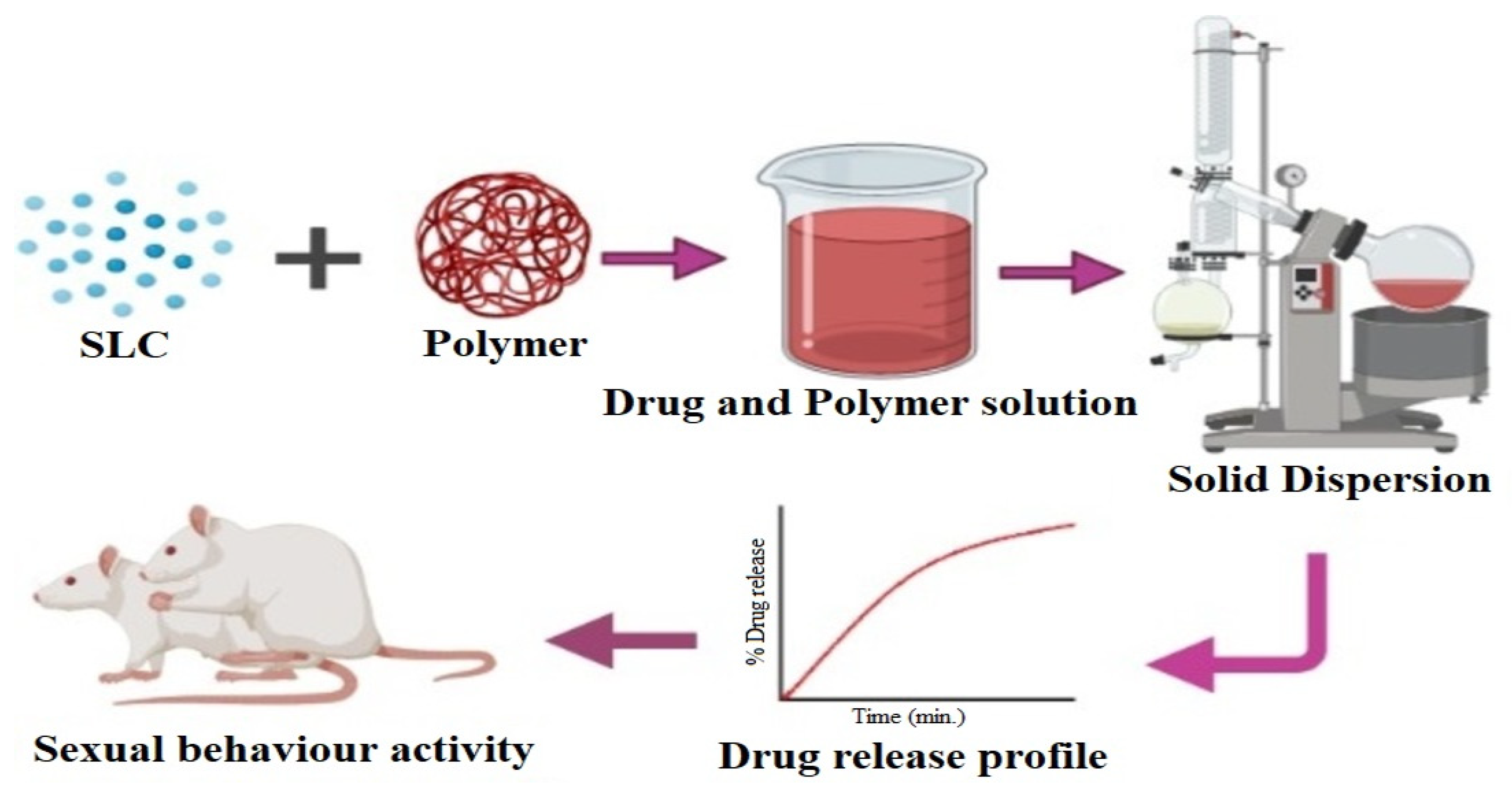
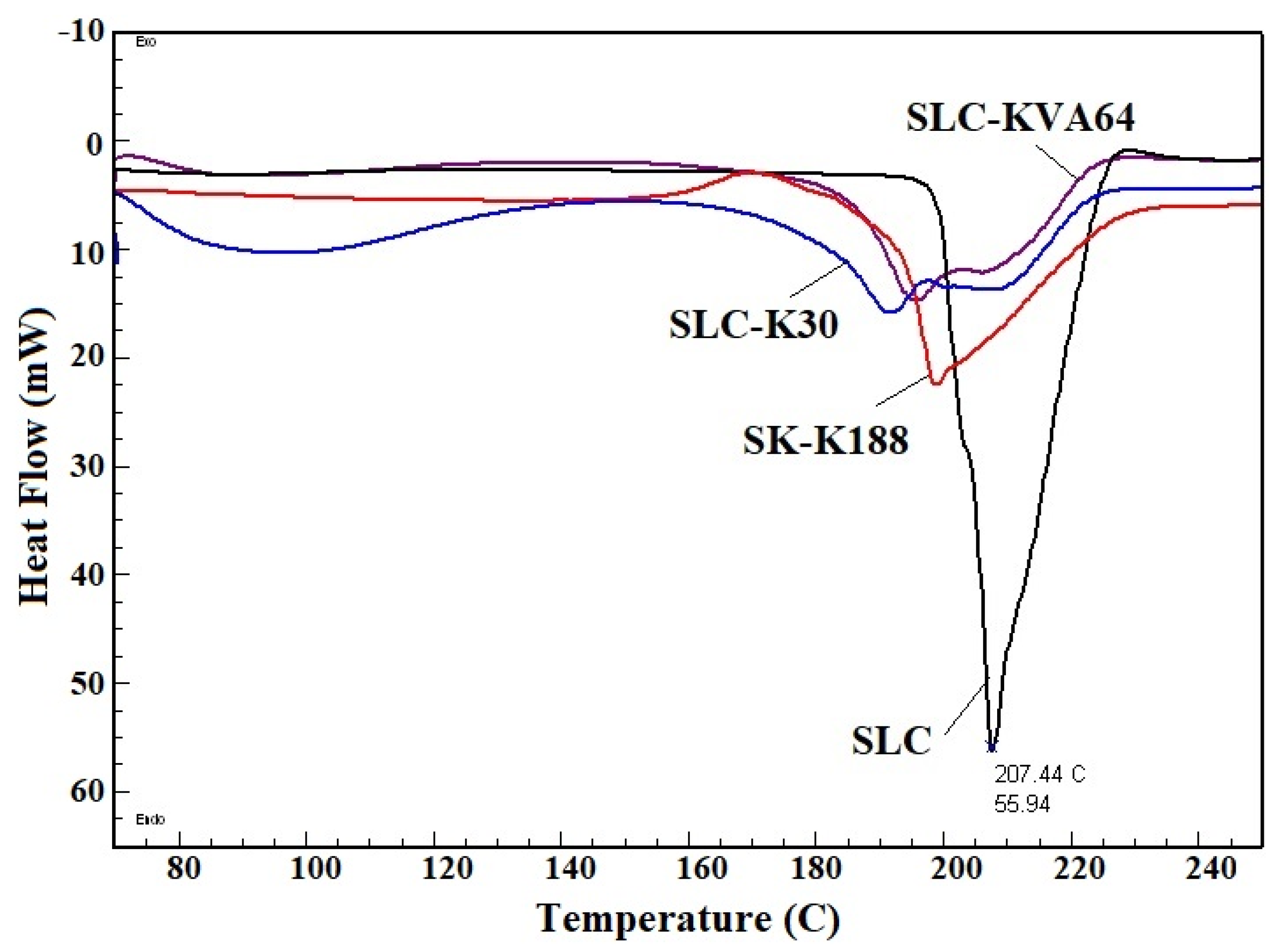
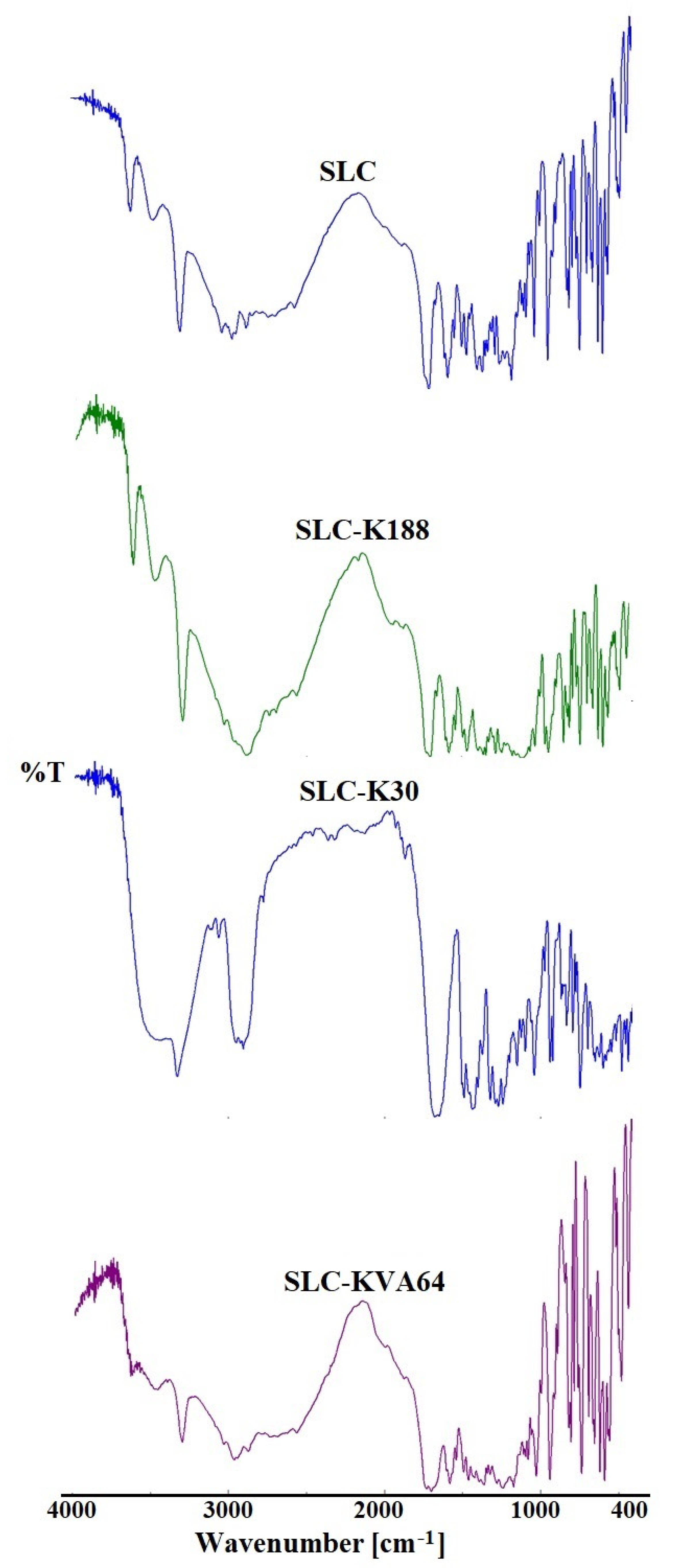


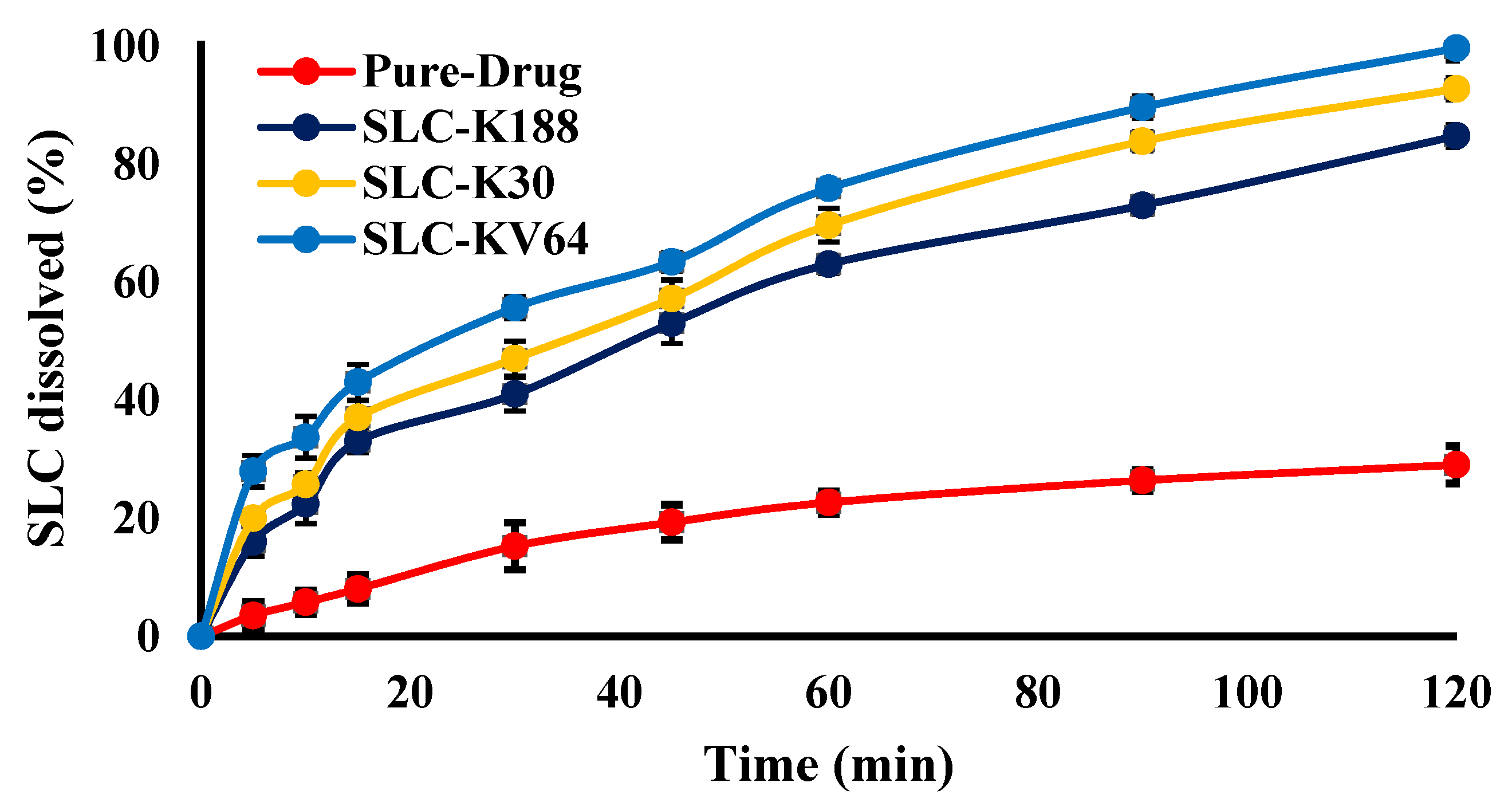

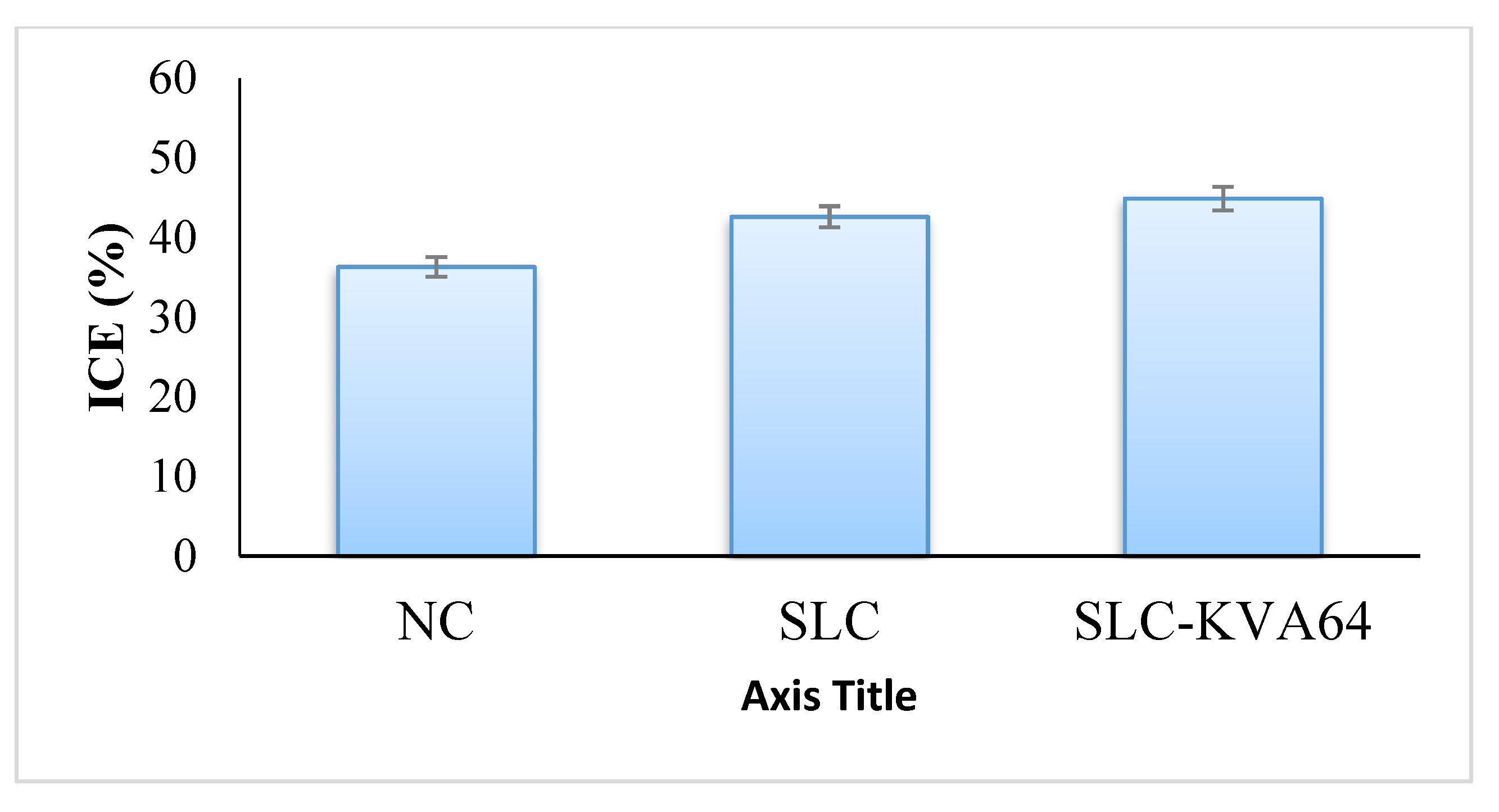
| Solid Dispersions | MDT (min) | f2 | Correlation Coefficient (R2) | ||||
|---|---|---|---|---|---|---|---|
| Zero Order | First Order | Matrix Diffusions | Korsmeyer-Peppas | N | |||
| SLC-K188 | 39.61 | 25.22 | 0.910 | 0.999 | 0.996 | 0.991 | 0.524 |
| SLC-K30 | 37.65 | 21.68 | 0.907 | 0.989 | 0.996 | 0.992 | 0.495 |
| SLC-KVA64 | 35.52 | 18.59 | 0.876 | 0.840 | 0.998 | 0.995 | 0.411 |
| Groups | ML (s) | MF | IL (s) | IF |
|---|---|---|---|---|
| NC | 122.71 ± 5.27 | 4.24 ± 0.48 | 245.15 ± 7.27 | 2.42 ± 0.15 |
| SLC-STD | 67.27 ± 2.18 * | 8.57 ± 0.37 * | 108.15 ± 3.52 * | 5.36 ± 0.36 * |
| SKV64 | 59.16 ± 2.11 *ǂ | 10.36 ± 0.42 *ǂ | 97.78 ± 3.16 *ǂ | 8.45 ± 0.50 *ǂ |
| Groups | EL-1 (s) | PEI (s) | EL-2 (s) |
|---|---|---|---|
| NC | 376.62 ± 8.72 | 496.64 ± 14.73 | 395.20 ± 7.12 |
| SDL-STD | 423.16 ± 11.46 * | 397.84 ± 8.46 * | 421.22 ± 8.25 * |
| SKV64 | 458.38 ± 10.27 *ǂ | 370.50 ± 8.50 *ǂ | 449.20 ± 9.28 *ǂ |
Publisher’s Note: MDPI stays neutral with regard to jurisdictional claims in published maps and institutional affiliations. |
© 2021 by the authors. Licensee MDPI, Basel, Switzerland. This article is an open access article distributed under the terms and conditions of the Creative Commons Attribution (CC BY) license (https://creativecommons.org/licenses/by/4.0/).
Share and Cite
Aldawsari, M.F.; Anwer, M.K.; Ahmed, M.M.; Fatima, F.; Soliman, G.A.; Bhatia, S.; Zafar, A.; Aboudzadeh, M.A. Enhanced Dissolution of Sildenafil Citrate Using Solid Dispersion with Hydrophilic Polymers: Physicochemical Characterization and In Vivo Sexual Behavior Studies in Male Rats. Polymers 2021, 13, 3512. https://doi.org/10.3390/polym13203512
Aldawsari MF, Anwer MK, Ahmed MM, Fatima F, Soliman GA, Bhatia S, Zafar A, Aboudzadeh MA. Enhanced Dissolution of Sildenafil Citrate Using Solid Dispersion with Hydrophilic Polymers: Physicochemical Characterization and In Vivo Sexual Behavior Studies in Male Rats. Polymers. 2021; 13(20):3512. https://doi.org/10.3390/polym13203512
Chicago/Turabian StyleAldawsari, Mohammed F., Md. Khalid Anwer, Mohammed Muqtader Ahmed, Farhat Fatima, Gamal A. Soliman, Saurabh Bhatia, Ameeduzzafar Zafar, and M. Ali Aboudzadeh. 2021. "Enhanced Dissolution of Sildenafil Citrate Using Solid Dispersion with Hydrophilic Polymers: Physicochemical Characterization and In Vivo Sexual Behavior Studies in Male Rats" Polymers 13, no. 20: 3512. https://doi.org/10.3390/polym13203512
APA StyleAldawsari, M. F., Anwer, M. K., Ahmed, M. M., Fatima, F., Soliman, G. A., Bhatia, S., Zafar, A., & Aboudzadeh, M. A. (2021). Enhanced Dissolution of Sildenafil Citrate Using Solid Dispersion with Hydrophilic Polymers: Physicochemical Characterization and In Vivo Sexual Behavior Studies in Male Rats. Polymers, 13(20), 3512. https://doi.org/10.3390/polym13203512










